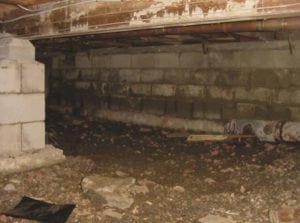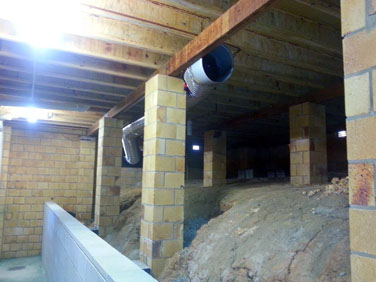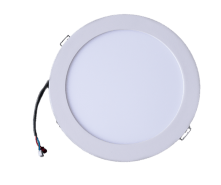Last Updated on July 21, 2025 by Solar Whiz
One of the main reasons people install sub floor ventilation fans is to remove and prevent mould growth in their homes.
Why Does Mould Grow Under Flooring?
According to the Australian Building Codes Board,
“Poor ventilation can result in the accumulation of moisture in subfloor areas, which may lead to mould growth, timber decay and potential structural issues.”
Condensation in Buildings Handbook, ABCB (2023)
Why Do Some Houses Have Sub Floor Ventilation Fans?
There are lots of reasons that sub floor ventilation fans might be installed in a home. Some of the major issues that sub floor ventilation deals with include:
- Mould and mildew growth
- Musty or damp smells inside the home
- Window condensation
- Timber floorboard warping or cupping
- Rising damp issues
- Pest and termite attraction due to damp conditions
- Structural damage to subfloor supports
- Faded or peeling wall paint
- Asthma and allergy symptom triggers
- Poor indoor air quality
Dealing with moisture in your home is important for maintaining structural integrity, improving comfort and reducing indoor air pollutants. If you believe your home has issues with sub floor ventilation, get in contact with us today!
How to Prevent and Get Rid of Mould in Sub Floor?
The best way to get rid of mould is to improve sub floor ventilation. This is also the best way to prevent it from growing in the first place! Sub floor ventilation fans will extract the damp, moist air from under the house and replace it with fresh and dry air from outside. This will help to dry out the sub floor environment and remove any mould that has been growing there.
There are multiple methods used to ventilate sub floor spaces. At Solar Whiz we customise our sub floor installations to the specific needs of our clients. In general, the 4 methods we rely on are:
How Solar Whiz Solves the Problem
Solar Whiz sub floor ventilation systems actively extract stale, moist air from under your floors using solar-powered fans. These systems don’t just move air around — they remove it entirely, helping prevent mould, rot, and musty smells from taking hold.
We offer a range of units to suit different home layouts, and for areas with limited sun, our hybrid option can tap into mains power. You can also choose between roof-mounted or wall-mounted systems, giving you installation flexibility without needing major modifications.
✅ Quiet operation compared to other fans
✅ Solar-powered = Zero-operating costs
✅ Hygrostat accessory available to monitor humidity
✅ Low-maintenance, high-efficiency design
Whether you’re dealing with a tight crawl space or an open sub floor, Solar Whiz has a solution tailored for your property.
Choosing the Right Subfloor Ventilation System
Not all subfloor spaces are the same, so the ventilation solution shouldn’t be either.
Consider These Key Factors:
1. Size of Your Subfloor Area
Larger spaces may need multiple fans or a higher-powered unit to effectively extract stale air.
2. Level of Moisture or Mould
If you’re already seeing visible mould or heavy dampness, go for a high-capacity system with stronger airflow (like the Solar Whiz AU-W-40).
3. Building Type
Homes, heritage buildings, or commercial spaces may require different setups—especially in multi-level or split-level constructions.
4. Accessibility of the Subfloor
Is the crawl space easily accessible? If it’s tight or uneven, a wall-mounted fan might be more practical than a ducted one.
5. Sunlight Availability
Solar-powered systems like Solar Whiz work efficiently even in overcast conditions, but placement still matters.
Discuss it with us, and we’ll tailor a custom solution for you.
Real Results: What Our Customers Say
We were dealing with musty smells and black mould patches under our floorboards. After installing Solar Whiz, the air became drier and the odour disappeared within days. It’s been over a year, and the mould hasn’t come back.”
— Helen M., Homeowner in Melbourne
Frequently Asked Questions
How do I know if my home needs sub floor ventilation?
Common signs include musty odours, dampness or rotting floorboards, mould on skirting boards, and condensation on windows. These are clear indicators that moisture is building up due to poor airflow in your subfloor.
Is solar subfloor ventilation effective in winter?
Yes. The Solar Whiz subfloor ventilation system continues to operate even in overcast or rainy conditions. For uninterrupted performance, Solar Whiz also offers a night operations kit that enables 24/7 ventilation, keeping your sub floor dry and ventilated all year round, even during cloudy or cold weather.
Do I need an electrician to install a subfloor fan?
It depends. Solar Whiz subfloor systems can be installed as a DIY project, and we provide a step-by-step installation guide to help you through the process. However, if the subfloor space is complex or hard to access, we always recommend getting a professional to ensure the system is installed correctly and works efficiently.






